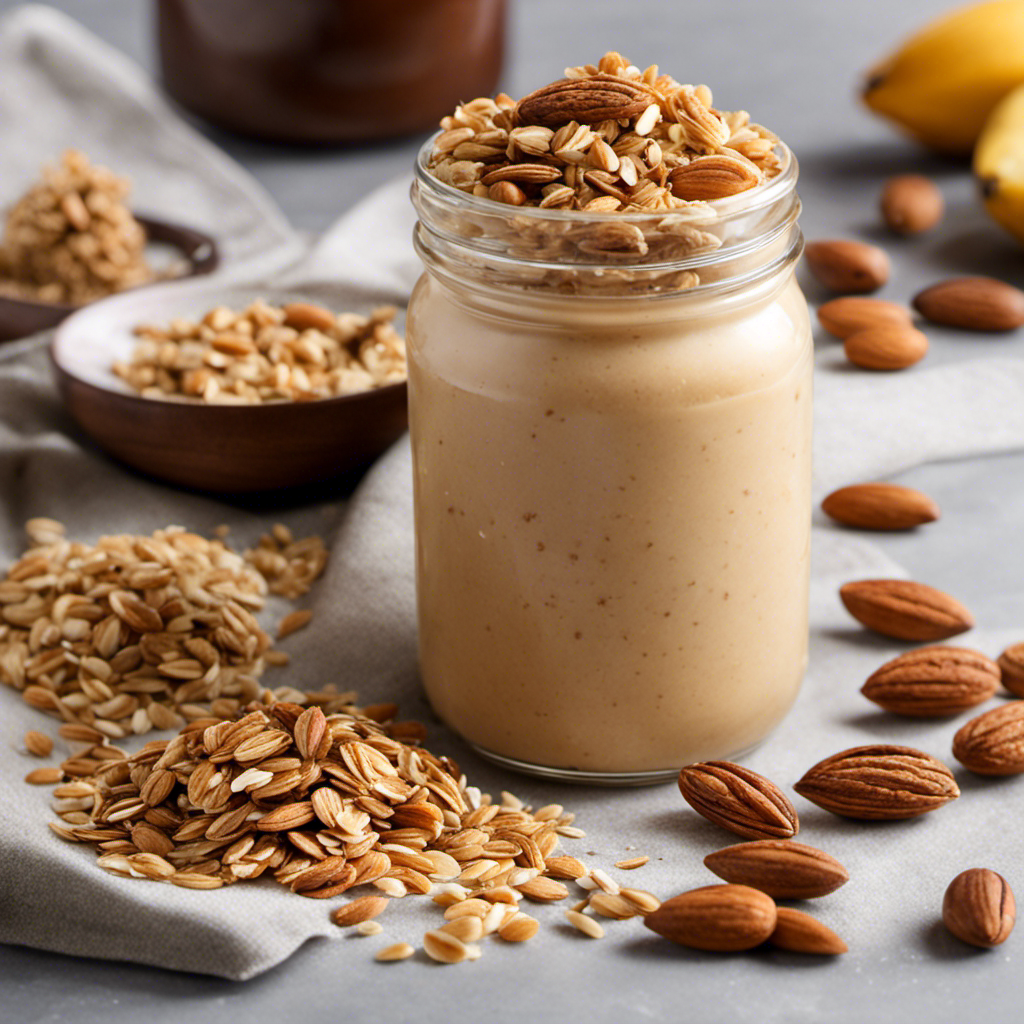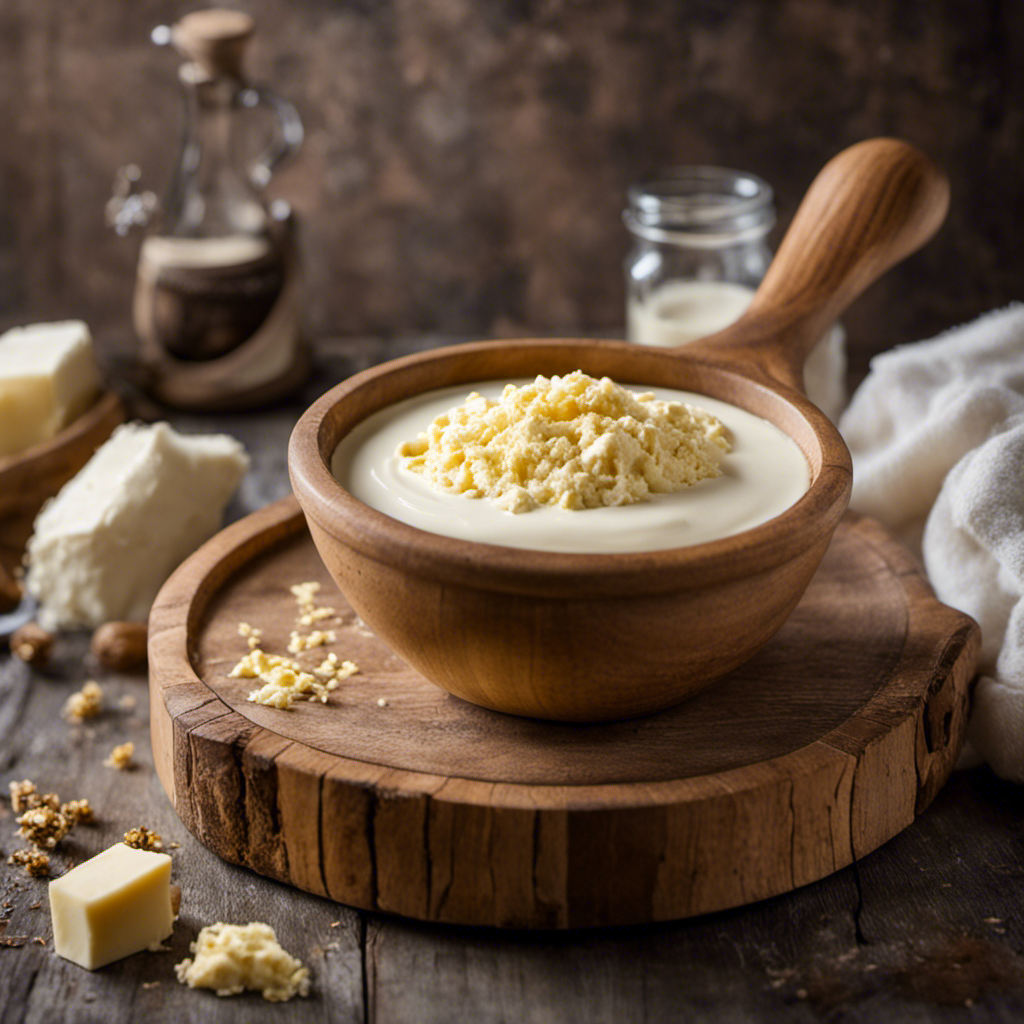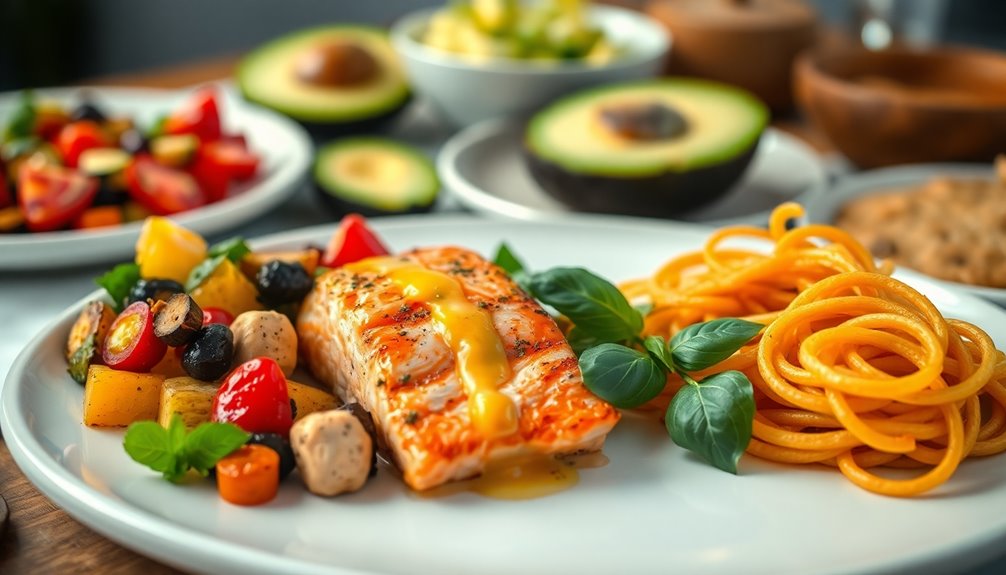Creating homemade granola butter is a total game-changer, like a luxurious dream. I will demonstrate how you can turn a few basic ingredients into a smooth spread that will take your breakfasts and snacks to the next level.
We’ll start by selecting the finest quality oats, nuts, and sweeteners. Then, we’ll prepare and blend them until we achieve the perfect consistency.
Get ready to spread the love with this delicious and versatile creation. Let’s dive in!
Key Takeaways
- Choose high-quality oats for the best texture and flavor
- Experiment with different sweeteners to add sweetness and unique taste
- Mix and match sweeteners to find your perfect combination
- Blend the ingredients longer for a smoother consistency
Selecting the Ingredients
When making granola butter, it’s important to choose high-quality ingredients. The first step is selecting the right oats. Opt for old-fashioned or rolled oats, as they provide the best texture and flavor. Avoid instant oats as they can make the butter too mushy.
Next, get creative with different sweeteners. You can experiment with honey, maple syrup, or even coconut sugar to add a touch of sweetness. Each sweetener will give your granola butter a unique taste, so feel free to mix and match to find your perfect combination. Don’t be afraid to try new flavors and combinations until you find the one that satisfies your taste buds.
Preparing the Granola
First, start by combining oats, nuts, and seeds in a food processor. The blending techniques used in this step are crucial for achieving the perfect texture and consistency of the granola butter. Pulse the ingredients until they are finely ground, but be careful not to overdo it, as you still want some texture in your butter.
Once the mixture is well blended, transfer it to a bowl and start exploring the flavor variations. You can add a pinch of cinnamon for warmth, a drizzle of honey for sweetness, or even a handful of dried fruits for a burst of tanginess. Get creative with your choices and experiment until you find your favorite combination.
The possibilities are endless, and each flavor variation will bring a unique twist to your homemade granola butter.
Blending the Granola
When it comes to blending granola, there are a few blender options that can help you achieve the desired texture.
One option is using a high-speed blender, such as a Vitamix, which can easily break down the granola into a smooth consistency.
Another option is using a food processor, which allows for more control over the texture, allowing you to achieve a chunkier or finer blend depending on your preference.
Lastly, if you don’t have a blender or food processor, you can also try blending the granola in small batches using a mortar and pestle for a more rustic texture.
Blender Options for Granola
There are several blender options you can use to make granola butter. One of my favorite options is using an immersion blender. This handheld blender is perfect for blending small batches of granola into a smooth and creamy butter. It’s easy to use and allows for precise control over the blending process.
Another great option is a food processor. This powerful machine can quickly and efficiently blend larger batches of granola into a smooth butter consistency. It’s perfect for making a big batch of granola butter to enjoy throughout the week.
Whether you choose to use an immersion blender or a food processor, both options will help you create a delicious and creamy granola butter that’s perfect for spreading on toast or adding to smoothies.
Achieving Desired Texture
To achieve your desired texture, consider blending the granola for a longer period of time. Blending techniques play a crucial role in creating the perfect granola butter consistency. Experimenting with different blending durations can result in varying textures, from smooth and creamy to chunky and crunchy. Here are some flavor experiments you can try:
| Blending Time | Texture |
|---|---|
| 1 minute | Creamy and spreadable |
| 2 minutes | Slightly chunky |
| 3 minutes | Smooth with a slight crunch |
| 4 minutes | Ultra-smooth and velvety |
Achieving the Desired Consistency
You can blend the ingredients longer for a smoother consistency.
When making granola butter, achieving the desired texture is crucial. Texture preferences vary from person to person, but most people prefer a smooth and creamy consistency.
To achieve this, make sure to blend the ingredients until they are fully incorporated and the mixture becomes thick and spreadable. Common mistakes include not blending the ingredients for long enough, resulting in a chunky or gritty texture. Another mistake is over-blending, which can turn the granola butter into a runny mess. Finding the right balance is key.
Once you have achieved the desired consistency, you can move on to storing and using your homemade granola butter.
Storing and Using Granola Butter
When it comes to storing and using granola butter, there are a few key tips to keep in mind for maximizing its shelf life.
First and foremost, it’s important to store it in an airtight container in a cool, dry place. This will help prevent any moisture from getting in and causing the butter to spoil.
Additionally, consider getting creative with how you use your granola butter – whether it’s spreading it on toast, drizzling it over pancakes, or even incorporating it into your favorite baked goods, the possibilities are endless!
Shelf Life Tips
If stored properly, granola butter can last for several months due to its high fat content. To maximize freshness and prevent spoilage, it’s important to follow a few simple tips.
Firstly, make sure to store your granola butter in an airtight container to keep out moisture and air, which can lead to rancidity. Keep it in a cool, dark place like your pantry or fridge to maintain its quality.
Additionally, avoid using wet spoons or utensils when scooping out the butter, as moisture can promote spoilage. If you want to extend its shelf life even further, you can also freeze granola butter in smaller portions, thawing only what you need.
Creative Recipe Ideas
To add a unique twist to your recipes, try incorporating granola butter into dishes like smoothies, cookies, or even salad dressings. Granola butter is a versatile and delicious ingredient that can enhance the flavor and texture of your dishes. Its creamy, nutty taste pairs well with both sweet and savory flavors, making it a great addition to a variety of recipes. Here are some creative ways to use granola butter:
| Recipe Ideas | Description |
|---|---|
| Granola Butter Smoothie Bowl | Blend granola butter with frozen bananas, almond milk, and your favorite toppings for a nutritious and filling breakfast option. |
| Granola Butter Chocolate Chip Cookies | Replace traditional butter with granola butter in your favorite cookie recipe for a unique and irresistible treat. |
| Granola Butter Salad Dressing | Whisk together granola butter, olive oil, lemon juice, and honey for a creamy and flavorful dressing that will elevate any salad. |
| Granola Butter Energy Bites | Combine granola butter, oats, honey, and dried fruit to create a delicious and nutritious snack that is perfect for on-the-go. |
| Granola Butter Stuffed French Toast | Spread granola butter between two slices of bread, dip in egg mixture, and cook until golden brown for a decadent breakfast or brunch dish. |
Additional Tips and Variations
One tip for making granola butter is to add a pinch of cinnamon for extra flavor. Cinnamon not only adds a warm and aromatic touch to the butter, but it also brings a host of health benefits.
Known for its anti-inflammatory properties, cinnamon can help reduce inflammation in the body and support a healthy immune system. Additionally, it has been shown to help regulate blood sugar levels and improve insulin sensitivity.
When combined with the nutritious ingredients in granola, such as oats, nuts, and seeds, the cinnamon-infused granola butter becomes a powerhouse of flavor and health benefits. So, don’t be afraid to experiment with different flavor options and incorporate spices like cinnamon to elevate the taste and nutritional profile of your homemade granola butter.
Frequently Asked Questions
Can I Use Flavored Granola to Make Granola Butter?
Sure, you can use flavored granola to make granola butter. It adds a delicious twist to the butter, enhancing its taste. Homemade granola butter has numerous benefits like being healthier and customizable to your liking.
How Long Does It Take to Prepare Granola Butter?
Making granola butter is a quick and easy process. It takes about 10 minutes to prepare and requires minimal ingredients. It’s like spreading a creamy, nutty dream on toast. So delicious!
Can I Use a Food Processor Instead of a Blender to Blend the Granola?
Yes, you can use a food processor instead of a blender to blend the granola. It may take a bit longer and the texture might be slightly different, but it will still work. As for alternative uses for granola butter, it can be spread on toast, mixed into smoothies, or used as a topping for pancakes or yogurt.
Can I Add Sweeteners Like Honey or Maple Syrup to the Granola Butter?
Yes, you can definitely add sweeteners like honey or maple syrup to your granola butter. Using natural sweeteners not only enhances the taste but also adds nutritional benefits to your homemade spreads.
Can I Use Granola Butter in Baking Recipes as a Substitute for Regular Butter?
Yes, you can definitely use granola butter in baking recipes as a substitute for regular butter. It adds a delicious nutty flavor and provides the benefits of using granola butter in recipes, like added nutrients and a unique twist to your baked goods.
Conclusion
In conclusion, making your own granola butter is a delicious and nutritious way to enjoy a unique spread. By carefully selecting quality ingredients and preparing the granola with love, you can create a flavorful blend that suits your taste buds.
Blending the granola to the desired consistency adds a smooth and creamy texture that is perfect for spreading on toast or adding to smoothies. Remember, ‘good things come to those who wait,’ so be patient as you store and use your homemade granola butter.
Enjoy the fruits of your labor and savor every spoonful of this delectable treat.










